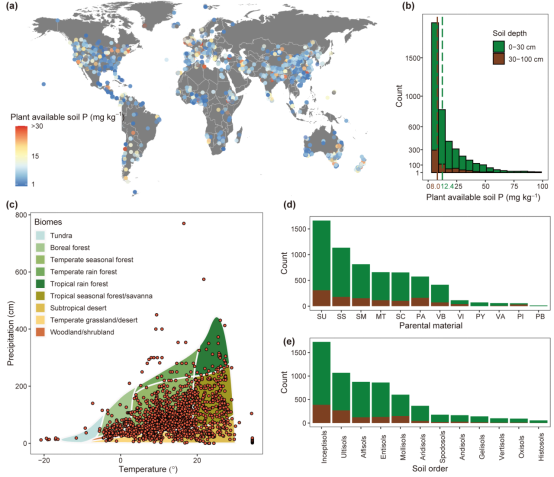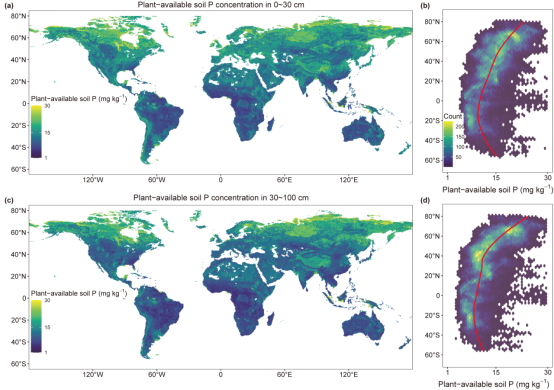Global distribution and influencing factors of plant-available phosphorus in (semi-)natural soils
Phosphorus (P) is frequently a limiting nutrient for plant production in terrestrial ecosystems. The soil is the primary source of P for plant growth, and plant-available soil P is the fraction of total soil P that is readily available to plants, especially plants without specialized carboxylate-releasing roots. Therefore, soil P availability affects the structure, functioning, and processes of terrestrial ecosystems, while varies by up to 4 orders of magnitude across the globe. Despite the large variation in plant-available soil P concentration, its global patterns and drivers remain poorly resolved. Examining the spatial patterns and environmental drivers of plant-available P in soil is fundamentally important for understanding the role of P in determining terrestrial primary production and carbon sequestration and its response to global change, such as rising atmospheric CO2 concentration, nitrogen deposition, and warming.
In this study, This compiled a global database of 6,253 plant-available soil phosphorus (P) observations from 3,353 (semi-)natural sites, screened from over 36,000 publications referencing five common extraction methods and reported in 887 studies. Using random forest models, This identified global patterns and key environmental drivers of plant-available soil P, with parent material and total soil P as top predictors, followed by climate and topography. Concentrations ranged from 0.01 to 99.0 mg kg⁻¹ and increased with latitude, despite large regional variation. Global plant-available P stocks were estimated at 0.73 ± 0.23 Pg (0–30 cm) and 1.59 ± 0.50 Pg (30–100 cm). These findings help identify P-limited ecosystems and inform global soil nutrient management.
The study titled “Global distribution and influencing factors of plant-available phosphorus in (semi-)natural soils” was published online in Global Biogeochemical cycles (5-year Impact Factor = 6.6). Dr LUO Xianzhen and Conghui Guo from South China Botanical Garden, is the first author of the paper, and Researcher Enqing Hou is the corresponding authors. Julian Helfenstein from Wageningen University and Hans Lambers from the University of Western Australia, among others, participated in this study. This research was jointly funded by National Natural Science Foundation of China and Guangdong Province Basic and Applied Basic Research Fund. The article link is: https://agupubs.onlinelibrary.wiley.com/doi/epdf/10.1029/2025GB008513.The original data, global maps of plant-available soil P, and R code used in the study are also freely available for download at: https://doi.org/10.6084/m9.figshare.24088368

Figure 1. The distribution of our site-level training data.(Imaged by LUO et al)

Figure 2. Global maps of plant-available soil phosphorus (P) concentration at the 0-30 cm and 30-100 cm soil depths.(Imaged by LUO et al)
File Download: